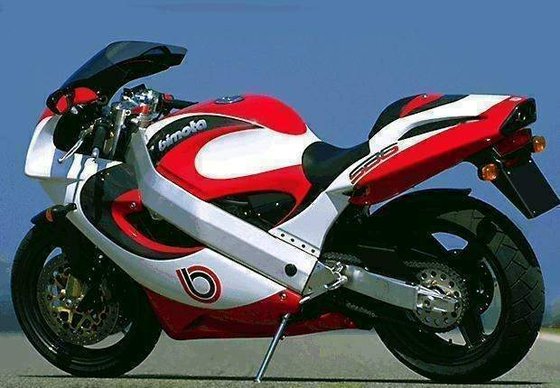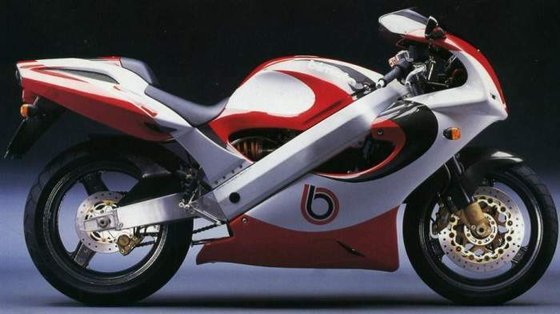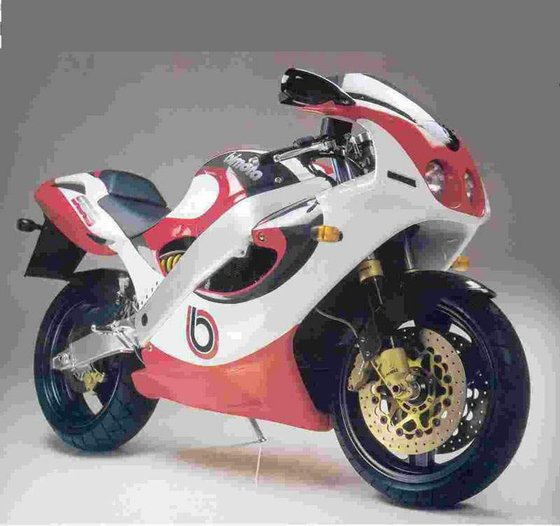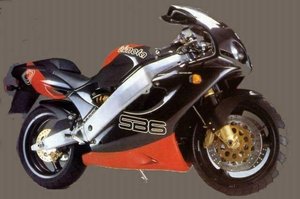Bimota SB6 R (1994-1996): A Symphony of Italian Flair and Japanese Muscle

Introduction
The Bimota SB6 R isn’t just a motorcycle—it’s a statement. Born from the marriage of Italian chassis wizardry and Suzuki’s brutish GSX-R1100 engine, this 1990s icon represents a time when exotic craftsmanship and raw power collided to create something truly special. With only 1,144 units ever produced, the SB6 R remains a rare gem in the motorcycling world, blending track-ready aggression with road-going charisma. Having recently thrown a leg over a pristine 1996 example, I can confirm: this bike isn’t just about nostalgia. It’s a visceral reminder of why we fall in love with motorcycles in the first place.
Design & First Impressions

At first glance, the SB6 R defies expectations. Its compact dimensions—54.2 inches (1,377 mm) of wheelbase and a dry weight of 190 kg (418.9 lbs)—make it look more like a middleweight sportbike than a liter-class predator. The aluminum “Straight Line Connection” (SLC) frame is a work of industrial art, with extruded beams flowing seamlessly into cast steering head and swingarm sections. Bimota’s obsession with minimizing joints creates a chassis that’s both featherlight and staggeringly rigid.
Carbon fiber accents dominate the bodywork, from the front fender to the seat cowl, while the twin under-seat exhausts (a clear nod to Ducati’s 916) exit with a purposeful growl. The paintwork gleams with a depth that modern water-based finishes struggle to match—though after 30 minutes in traffic, you’ll also notice another trait it shares with the 916: enough rear-end heat to roast chestnuts.
The riding position is pure ’90s superbike—aggressive without being torturous. The 755 mm (29.7-inch) seat height accommodates most riders, but the narrow perch leaves no doubt: this is a solo machine. Clip-ons are low, rearsets are high, and the analog tachometer dominates a surprisingly minimalist dash. It’s a cockpit designed for focus, not comfort.
Engine Performance: Suzuki’s Heart in an Italian Suit

Crack the throttle on the SB6 R, and any doubts about its 1074cc GSX-R-derived engine vanish. Bimota’s tweaks—including hotter cams, less restrictive intake trumpets, and a free-flowing exhaust—unleash 156 hp (116 kW) at 10,000 RPM and 117.7 Nm (86.8 lb-ft) of torque at 9,000 RPM. These numbers might seem modest by today’s standards, but the delivery is anything but.
From 2,500 RPM, the inline-four pulls with a linear ferocity that builds to a spine-tingling crescendo. Roll on in second gear, and the front wheel claws at the sky with minimal provocation. Keep it pinned, and the SB6 R devours the quarter mile in 10.6 seconds, crossing the line at 219.5 km/h (136.4 mph). Top speed? A claimed 275.5 km/h (171.2 mph)—enough to humble most modern nakeds.
What surprises is the engine’s versatility. Mikuni carburetors (4x38mm) deliver crisp throttle response without the flat spots that plague lesser-tuned setups. Around town, it’ll lug at 3,000 RPM without complaint, though the real magic lives above 6,000 RPM. The 5-speed gearbox (a carryover from the GSX-R1100) shifts with mechanical precision, though the clutch feels slightly overmatched during aggressive launches.
Handling: A Dance Partner That Reads Your Mind
If the engine is the SB6 R’s brawn, the chassis is its ballet dancer. The SLC frame’s stiffness allows suspension components to work with laser focus. Up front, 46mm Paoli forks (adjustable for compression and rebound) offer 120mm of travel, while the Öhlins rear shock (also fully adjustable) manages a rising-rate linkage system.
On twisty backroads, the Bimota feels telepathic. Turn-in is instantaneous, thanks to the short wheelbase and 120/60-ZR17 front tire. Mid-corner bumps are absorbed without drama, and exits are a game of “how soon can I get back to WOT?” The 180/55-ZR17 rear Michelin—a wide tire for its era—hooks up predictably, though modern rubber would unlock even more grip.
Brembo’s dual 320mm front discs and 4-piston calipers provide strong stopping power, albeit with less initial bite than radial-mount systems. The rear 230mm disc is largely decorative unless you’re trail-braking into hairpins. At speed, the SB6 R’s stability is remarkable for such a compact machine—no headshake, no wandering, just planted confidence.
Competition: How the SB6 R Stacks Up
In the mid-’90s, the SB6 R faced three rivals:
- Ducati 916 (1994-1998):
- Pros: Timeless design, soulful V-twin soundtrack, superior low-end grunt.
- Cons: Half the horsepower (109 hp), Desmo maintenance costs, cramped ergonomics.
-
Verdict: The 916 wins hearts; the SB6 R wins drag races.
-
Honda CBR900RR Fireblade (1992-1999):
- Pros: Lighter (185 kg / 408 lbs), more affordable, easier to live with.
- Cons: 136 hp peak power feels tame next to the Bimota’s 156 hp.
-
Verdict: The sensible choice—but since when has motorcycling been sensible?
-
Suzuki GSX-R1100 (1992-1998):
- Pros: Same engine bones, lower price, proven reliability.
- Cons: Flabby chassis, budget suspension, dated looks.
- Verdict: The GSX-R is a sledgehammer; the SB6 R is a scalpel.
The Bimota’s ace card? Exclusivity. While Japanese rivals flooded dealerships, the SB6 R offered boutique craftsmanship and a 170-mph thrill few could replicate.
Maintenance: Keeping the Legend Alive
Owning an SB6 R in 2024 isn’t without challenges, but the Suzuki DNA simplifies upkeep:
- Engine Care:
- Spark Plugs: NGK CR9E (gap 0.7 mm) or iridium CR9EIX for longevity.
- Coolant: Use silicate-free ethylene glycol (50/50 mix) to protect the aluminum engine.
-
Valve Adjustments: Every 12,000 km (7,500 miles)—easier than Ducati’s Desmo service.
-
Chassis Upgrades:
- Brake Pads: Swap to sintered compounds (e.g., EBC FA416HH) for better bite.
- Chain & Sprockets: DID 525VX2 chain with 16/41 gearing sharpens acceleration.
-
Suspension: Refresh Öhlins shock fluid every 2 years; MOTOPARTS.store stocks rebuild kits.
-
Common Issues:
- Carburetor Sync: Essential annually to maintain smooth low-RPM operation.
- Exhaust Heat: Ceramic-coat the headers or add a heat shield to protect the rider.
- Electrics: Upgrade the OEM reg/rectifier to a modern MOSFET unit.
Final Thoughts
The Bimota SB6 R isn’t perfect. It’s hot, expensive to insure, and demands a rider who respects its limits. But perfection is boring. What this Italian-Japanese hybrid offers is something far more compelling: a raw, unfiltered connection between man and machine. Every twist of the throttle, every lean into a corner, feels earned.
In an era of rider aids and homogenized design, the SB6 R stands as a reminder of when motorcycles were dangerous—and all the more thrilling for it. Whether you’re hunting down a well-preserved example or upgrading your current ride, MOTOPARTS.store has the expertise and components to keep this ’90s legend shredding tarmac for decades to come.
Ride hard. Ride rare.
Specifications sheet
| Engine | |
|---|---|
| Stroke: | Four-stroke |
| Max power: | 116 kW | 156.0 hp |
| Max torque: | 100 Nm |
| Fuel system: | 4x 38mm Mikuni carburetors |
| Max power @: | 10000 rpm |
| Displacement: | 1074 ccm |
| Max torque @: | 8400 rpm |
| Configuration: | Inline |
| Cooling system: | Liquid-cooled |
| Compression ratio: | 11.2:1 |
| Number of cylinders: | 4 |
| Valves per cylinder: | 4 |
| Dimensions | |
|---|---|
| Dry weight: | 190 |
| Seat height: | 755 mm (29.7 in) |
| Fuel tank capacity: | 19.5 L (5.2 US gal) |
| Drivetrain | |
|---|---|
| Final drive: | chain |
| Transmission: | 5-speed |
| Performance | |
|---|---|
| Top speed: | 275.5 km/h (171.2 mph) |
| Fuel consumption (average): | 6.5 l/100km (36.2 mpg) |
| Maintainance | |
|---|---|
| Brake fluid: | DOT 4 |
| Spark plugs: | NGK CR9E or NGK CR9EIX |
| Spark plug gap: | 0.7 |
| Chassis and Suspension | |
|---|---|
| Frame: | Aluminum double perimeter beam "Straight Line Connection" (SLC) |
| Rear tire: | 180/55-z-17 |
| Front tire: | 120/60-z-17 |
| Rear brakes: | Single 230mm disc, 2-piston caliper |
| Front brakes: | 2x 320mm discs, 4-piston calipers |
| Rear suspension: | Öhlins rising rate monoshock, adjustable for compression and rebound |
| Front suspension: | 46mm Paoli forks, adjustable for compression and rebound |


















